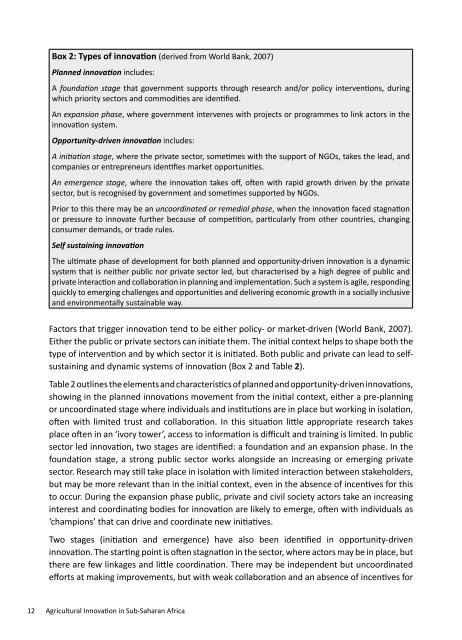agrl_innovations_in_ssa.pdf?utm_content=buffercb41d&utm_medium=social&utm_source=twitter
agrl_innovations_in_ssa.pdf?utm_content=buffercb41d&utm_medium=social&utm_source=twitter
agrl_innovations_in_ssa.pdf?utm_content=buffercb41d&utm_medium=social&utm_source=twitter
Create successful ePaper yourself
Turn your PDF publications into a flip-book with our unique Google optimized e-Paper software.
Box 2: Types of <strong>in</strong>novation (derived from World Bank, 2007)<br />
Planned <strong>in</strong>novation <strong>in</strong>cludes:<br />
A foundation stage that government supports through research and/or policy <strong>in</strong>terventions, dur<strong>in</strong>g<br />
which priority sectors and commodities are identified.<br />
An expansion phase, where government <strong>in</strong>tervenes with projects or programmes to l<strong>in</strong>k actors <strong>in</strong> the<br />
<strong>in</strong>novation system.<br />
Opportunity-driven <strong>in</strong>novation <strong>in</strong>cludes:<br />
A <strong>in</strong>itiation stage, where the private sector, sometimes with the support of NGOs, takes the lead, and<br />
companies or entrepreneurs identifies market opportunities.<br />
An emergence stage, where the <strong>in</strong>novation takes off, often with rapid growth driven by the private<br />
sector, but is recognised by government and sometimes supported by NGOs.<br />
Prior to this there may be an uncoord<strong>in</strong>ated or remedial phase, when the <strong>in</strong>novation faced stagnation<br />
or pressure to <strong>in</strong>novate further because of competition, particularly from other countries, chang<strong>in</strong>g<br />
consumer demands, or trade rules.<br />
Self susta<strong>in</strong><strong>in</strong>g <strong>in</strong>novation<br />
The ultimate phase of development for both planned and opportunity-driven <strong>in</strong>novation is a dynamic<br />
system that is neither public nor private sector led, but characterised by a high degree of public and<br />
private <strong>in</strong>teraction and collaboration <strong>in</strong> plann<strong>in</strong>g and implementation. Such a system is agile, respond<strong>in</strong>g<br />
quickly to emerg<strong>in</strong>g challenges and opportunities and deliver<strong>in</strong>g economic growth <strong>in</strong> a socially <strong>in</strong>clusive<br />
and environmentally susta<strong>in</strong>able way.<br />
Factors that trigger <strong>in</strong>novation tend to be either policy- or market-driven (World Bank, 2007).<br />
Either the public or private sectors can <strong>in</strong>itiate them. The <strong>in</strong>itial context helps to shape both the<br />
type of <strong>in</strong>tervention and by which sector it is <strong>in</strong>itiated. Both public and private can lead to selfsusta<strong>in</strong><strong>in</strong>g<br />
and dynamic systems of <strong>in</strong>novation (Box 2 and Table 2).<br />
Table 2 outl<strong>in</strong>es the elements and characteristics of planned and opportunity-driven <strong><strong>in</strong>novations</strong>,<br />
show<strong>in</strong>g <strong>in</strong> the planned <strong><strong>in</strong>novations</strong> movement from the <strong>in</strong>itial context, either a pre-plann<strong>in</strong>g<br />
or uncoord<strong>in</strong>ated stage where <strong>in</strong>dividuals and <strong>in</strong>stitutions are <strong>in</strong> place but work<strong>in</strong>g <strong>in</strong> isolation,<br />
often with limited trust and collaboration. In this situation little appropriate research takes<br />
place often <strong>in</strong> an ‘ivory tower’, access to <strong>in</strong>formation is difficult and tra<strong>in</strong><strong>in</strong>g is limited. In public<br />
sector led <strong>in</strong>novation, two stages are identified: a foundation and an expansion phase. In the<br />
foundation stage, a strong public sector works alongside an <strong>in</strong>creas<strong>in</strong>g or emerg<strong>in</strong>g private<br />
sector. Research may still take place <strong>in</strong> isolation with limited <strong>in</strong>teraction between stakeholders,<br />
but may be more relevant than <strong>in</strong> the <strong>in</strong>itial context, even <strong>in</strong> the absence of <strong>in</strong>centives for this<br />
to occur. Dur<strong>in</strong>g the expansion phase public, private and civil society actors take an <strong>in</strong>creas<strong>in</strong>g<br />
<strong>in</strong>terest and coord<strong>in</strong>at<strong>in</strong>g bodies for <strong>in</strong>novation are likely to emerge, often with <strong>in</strong>dividuals as<br />
‘champions’ that can drive and coord<strong>in</strong>ate new <strong>in</strong>itiatives.<br />
Two stages (<strong>in</strong>itiation and emergence) have also been identified <strong>in</strong> opportunity-driven<br />
<strong>in</strong>novation. The start<strong>in</strong>g po<strong>in</strong>t is often stagnation <strong>in</strong> the sector, where actors may be <strong>in</strong> place, but<br />
there are few l<strong>in</strong>kages and little coord<strong>in</strong>ation. There may be <strong>in</strong>dependent but uncoord<strong>in</strong>ated<br />
efforts at mak<strong>in</strong>g improvements, but with weak collaboration and an absence of <strong>in</strong>centives for<br />
12 Agricultural Innovation <strong>in</strong> Sub-Saharan Africa






